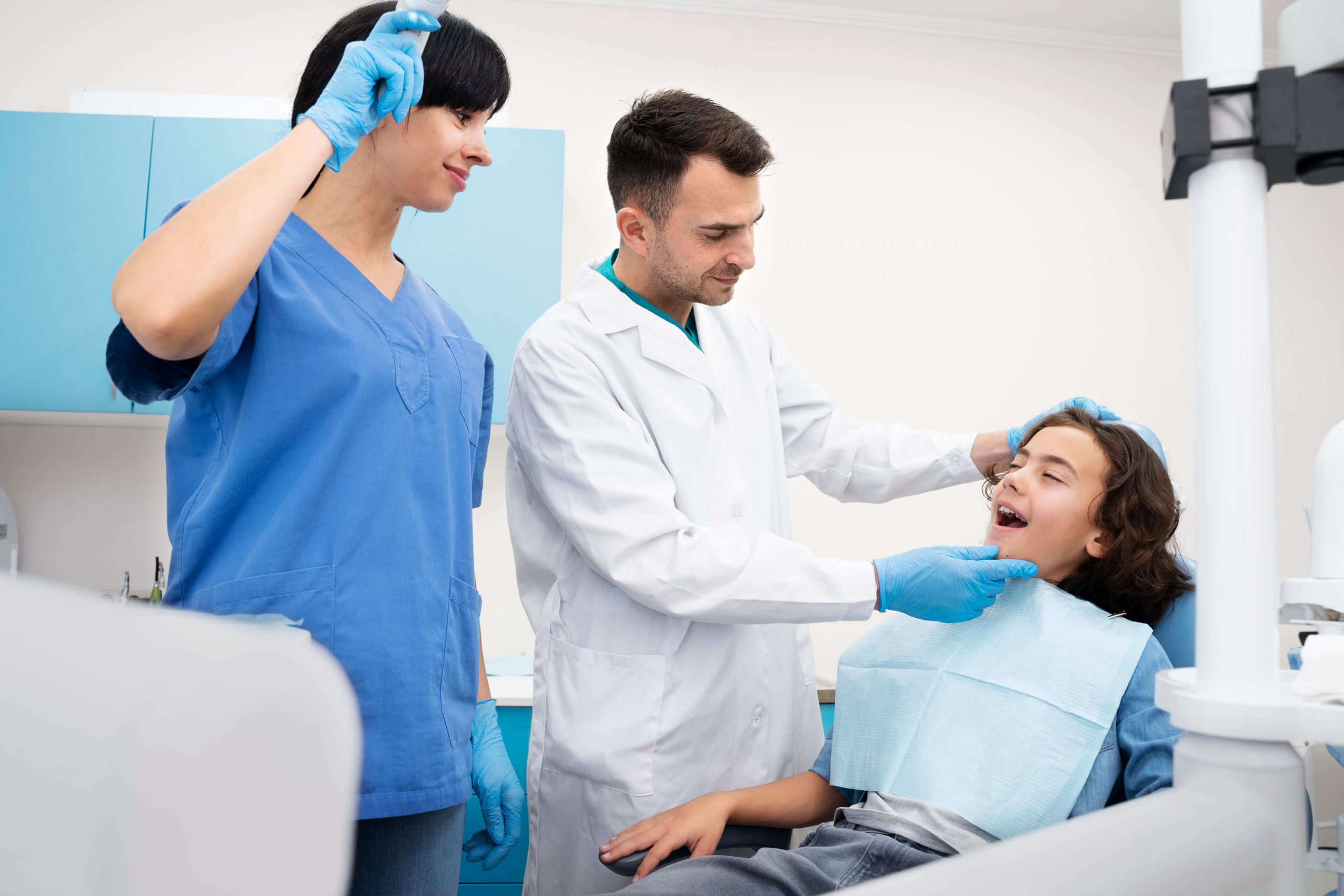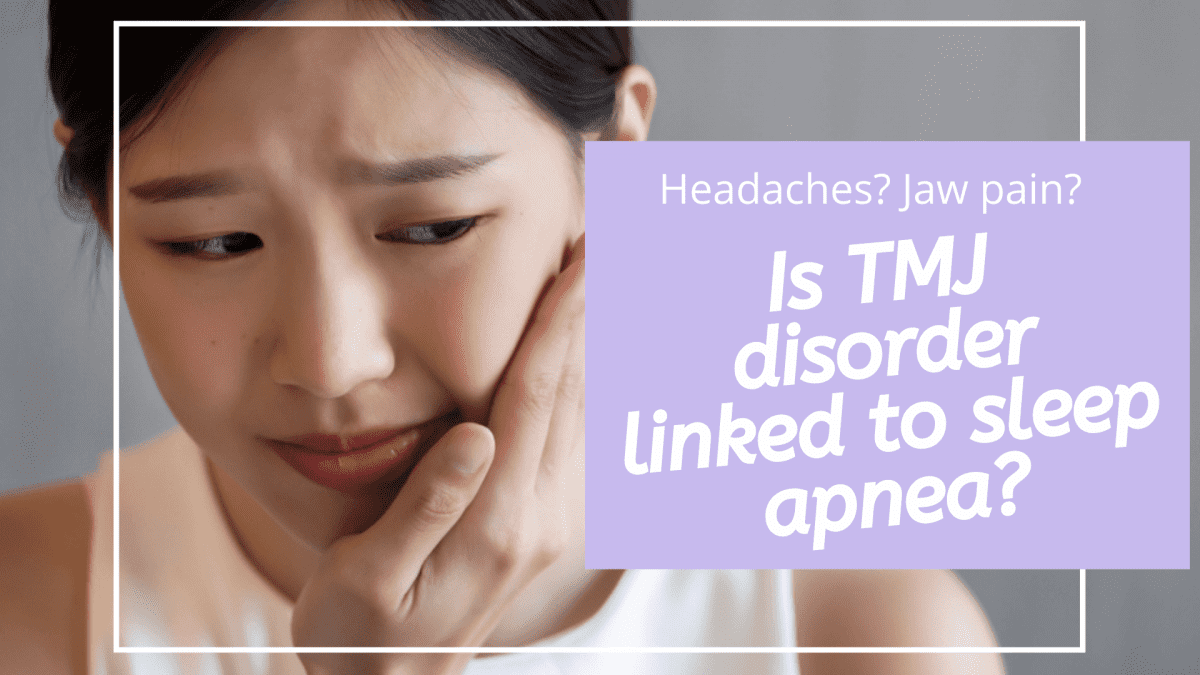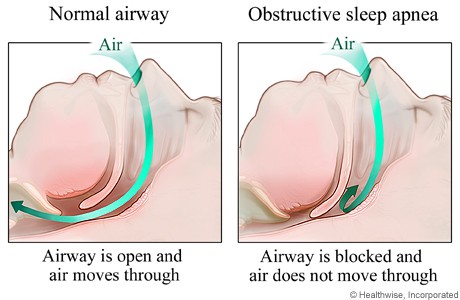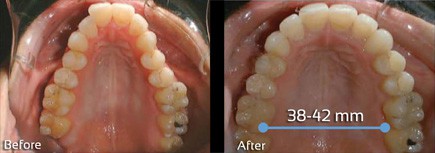
TMJ Pain is a side effect of Sleep Apnea
Small jaws and spaces in the mouth and nasal passageways leads to sleep and breathing problems. It only makes sense that teeth will be crowded if mouth and jaw structure are small too. Breathing is one of the most basic functions of life. Breathing occurs through the mouth and nasal passageways. If the mouth and nasal passageways are small, of course breathing air through these spaces will be more difficult. So of course there is a link between crowded teeth, small mouth and upper airway restriction syndrome. But what about TMJ problems? Research shows that 77% of people with sleep apnea clench their teeth.

tmj pain sleep apnea

Palatal Expanders Can Cure Sleep Apnea
Corrective treatments for obstructive sleep apnea that do not involve surgery or a CPAP device do exist. Two such examples are the Homeoblock appliance and Vivos DNA appliance therapy. Adult anterior growth appliances can promote new bone growth in the mouth and nasal passageways. These appliances are called expanders because of their ability to increase the size and space in the jaws. The upper jaw bone is the base of the nasal passageways. The expansion decreases airway resistance and improves breathing while sleeping. The DNA (day time, night time appliance) works for adults by expanding the palate and surrounding jaw structure.
Contact Dr. Adams for a complimentary appliance consultation

homeoblock appliance 3 300×247 1
Sleep Apnea TMJ Link Video
ALF compared to DNA Appliance Video:
Kids Expansion Appliances
Expanders and growth appliances will cure pediatric sleep apnea with proper attention to other conditions such as tongue tie and lip frenums. Appliances for children include Schwarz, ALF and Crozat. No one appliance is the “best” appliance. It depends on the growth needs of the child. What the child can tolerate and what appliance the dentist knows how to use are considerations too.

dna appliance tmj chevy chase bethesda 13
Aligning Teeth is More than Cosmetic
Healthy natural teeth are essential for providing beauty to your smiles. Straight and well aligned teeth are not only necessary for proper chewing, biting and eating food but these teeth enhance self-esteem and confidence at work and during presentations in the universities. Crooked and poorly aligned teeth due to crowding of teeth result in compromised smiles and loss of confidence. In addition to cosmetic concerns, crowding of teeth allow accumulation of food debris and bacteria in areas between your teeth. Crowded teeth do not allow thorough cleaning of teeth through tooth brushing and mouth rinsing. These teeth provide a nidus for bacterial growth and impaction of food particles from your diet. The DNA dental appliance is also great for straightening teeth since is creates more space in the mouth for teeth to fit. Other appliances do exist such as the ALF appliance vs the DNA appliance.
What causes Crooked-Crowded Teeth?
- Frequent and consistent use of pacifiers and feeding bottles during infancy and early childhood especially in children above 3 years of age
- Tongue tie and poor tongue function
- Cleft lip and cleft palate patients,
- Thumb sucking habit in infants, toddlers and children,
- Injuries and trauma to the face, jaws and teeth,
- Road side accidents,
- Cysts and tumors affecting face and jaws,
- Abnormally shaped teeth,
- Teeth with dilacerated roots,
- Impacted teeth stuck within the bone which push or damage roots of adjacent erupted teeth.
What are the various problems caused by crowded teeth?
- Excessive wear of natural teeth,
- Headaches,
- Pain in the jaws and teeth,
- Temporomandibular pain dysfunction disease,
- Difficulty in eating and chewing,
- Breathing difficulties,
- Sleep apnea,
- Upper airway resistance syndrome or UARS
- Postural problems including tight neck, upper back and shoulders
- Forward head posture
- Food lodgment in narrow areas between crooked teeth,
- Increased chances of tooth decay,
- Strain teeth, muscles of face and jaws,
- Tooth fracture,
- High prevalence of gum diseases in patients with crowded teeth.
- Tooth loss and the need for full mouth implants
Can crowded teeth cause bruxism, sleep apnea and UARS?
Jaw problems and poorly aligned teeth can be extremely problematic. Disproportioned teeth lead to disturbed bite and lead to night time grinding of teeth, increased stress, breathing difficulties and TMJ disorder. Treatments related to crowded teeth such as braces can also lead to sleep deprivation, stress accumulation and respiratory restriction. A popular treatment for crowded teeth in kids is natural orthodontics. Natural orthodontics is the assistance of natural forces such as tongue and chewing forces in aligning teeth.
What is sleep apnea?
Continuous and repetitive blockage of your airway passages during sleep hours can cause discontinued or no breathing at night. This obstruction of the breathing passages reduces the amount of fresh oxygen within your lungs. The end result is usually the production of loud and audible snoring sounds depicting choked airways. These loud snores can be heard due to forced breathing and are indicative of a serious disorder known as sleep apnea most commonly obstructive sleep apnea.
Snoring sounds are usually considered a normal phenomenon during sleep and ignored by majority of us. Even we do not know if we have ourselves developed snoring at night unless our roommates or spouses tell us about this finding. Sleep apnea is an extremely common and potentially fatal abnormality. Serious consideration and immediate consultation with your local dentist is strongly advised to avoid serious complications in future.
What happens during sleep apnea?
During sleep apnea, your breathing process gets disrupted or stops and then re-starts. The whole process is repeated again and again during sleeping hours. Snoring may or may not occur in conjunction with sleep apnea. Shallow Breathing is interrupted at frequent intervals during sleep. Multiple breathing pauses measured around 10-20 seconds occur during this time for over 100 times adversely affecting the sleep cycle.
Deep and uninterrupted sleep is required for regaining energy. Energy is not regained and re-filled when sufficient rest is not achieved. Light and interrupted sleep does not fulfill the requirements of human body.
How does sleep apnea develop during sleep?
Continuous and recurrent narrowing down and collapsed pharyngeal airway passages result in forced breathing and labored breathing efforts by the affected person in order to provide oxygen to the human body for survival. This phenomenon leads to disturbed and fragmented sleeping, loud snoring sounds and abnormal required gas exchange within the blood.
Sleep apnea episodes cause reduced oxygen levels in the bloodstream resulting in the loss of much needed oxygen supply to the brain tissues. This creates an emergency state and brain death can occur if it lasts for long time span. Body survival system immediately takes action and sleep interruption occurs triggering forced breathing for oxygen supply to the brain. Loud Snoring sound are produced in response to this reflex which mimics choking noises.
What are various types of sleep apnea?
- Obstructive sleep apnea is the most common type characterized by loud snoring sounds.
- Central sleep apnea is less frequent type in which snoring occurs rarely.
- Complex sleep apnea is usually the combination of the above two types.
What are the consequences of sleep apnea?
Sleep apnea causes interrupted breathing resulting in lethargy, tiredness and slowness of reflexes during whole day at work. Breathing pauses of about 10-20 seconds occur between sleep ranging in frequently from a few to more than 100 times per night. Freshness of mind and energy regain is not achieved which is the basic purpose of sleep. Sleep deprivation results in,
- Slow reflexes,
- Lethargic attitude,
- Dizziness,
- Loss of concentration at work,
- Inability to drive properly,
- Accidents,
- Increased anxiety, depression, stress,
- High blood pressure and frequent episodes of headache,
- Weight gain.
Which signs and symptoms are associated with sleep apnea?
- Loud snoring occurs during sleep apnea especially during obstructive type,
- Daytime sleepiness occurs irrespective of long stay in bed at night,
- Laziness,
- Lack of concentration,
- Long pauses and stops during breathing,
- Increased stress, tension and anxiety,
- Dryness of mouth can occur,
- Throat and neck infections,
- Increased nocturnal urination occurrences,
- Disturbed growth and development in infants and small children,
- Mouth breathing habit.
What is teeth grinding and UARS?
Breathing related sleep problems occur in majority of people suffering from teeth grinding habits. Teeth grinding which may occur during night or daytime, usually affects 8-31% of the population. Treatments for teeth and jaw clenching do exist. The breathing related issues associated with teeth grinding habit are somewhat different in some people when compared with obstructive sleep apnea patients. The syndrome with distinctive features in such cases is termed as upper airway resistance or restriction syndrome abbreviated as UARS. The syndrome is characterized by clenching of the teeth when the airway becomes obstructed by the tongue or other soft tissue.
Various features which can characterize people with teeth grinding habits and development of this airway breathing problem are,
- Majority will be females,
- Persons with short and thin neck,
- Small jaws,
- Limited mouth opening,
- Crowded and mal-aligned teeth,
- Females undergoing braces treatment for crooked teeth,
- Deep bite problems,
- People with digestive problems,
- People with disturbed chewing, biting and eating,
- People suffering from depression, anxiety and stress,
- Lethargic persons,
- Daytime dizziness and drowsiness,
- People with habit of sleeping on their stomach with face down on the pillows,
- People who are unable to sleep on their back,
- Tiny mouth,
- People with low blood pressure,
- People who often faint or suffer from light headedness,
- People affected with deviated nasal septum,
- People who are suffering from Temporomandibular pain dysfunction syndrome,
- Chronic stuffed nose,
- Infected sinuses,
- Pain and discomfort in sinuses,
- Migraine symptoms,
- Digestive disorders such as crohn’s disease, irritable bowel syndrome, bloating, flatulence, constipation, diarrhea,
- Cold and clammy skin, hands and feet,
- Brain fog,
- Skin allergy,
- Skin rashes,
- Non-cardiac chest pain and discomfort.
How can UARS be diagnosed?
Diagnosis and differentiation of UARS from OSA is quite difficult. However, few tests and clinical features may be helpful in this regard.
- Sleep tests i.e. polysomnography PSG,
- Apnea Hypnea Index (AHI),
- Sleep pauses,
- Chronic pain in the pelvic region,
- Non-cardiac chest pain,
- Fibromyalgia,
- Tension headache hyperventilation syndrome,
- Chronic fatigue syndrome,
- Teeth grinding and clenching,
- Frequent respiratory effort related arousals,
- Lack of deep REM sleep,
- Loose fatty tissues of the throat collapsing back into the airway,
- Position of the tongue (falling back) during sleep,
- In obstructive sleep apnea (OSA), airway obstruction develops then apnea occurs followed by arousal. UARS is different and is characterized by airway obstruction followed by arousal or RERA (respiratory effort related arousals). No apnea occurs in UARS,
- No pauses of breathing occur in UARS characterized by AHI value 0.
Why breathing pauses do not occur in UARS?
Activation of sympathetic stress system occurs due to respiratory effort related arousals which are seen in UARS. Opening of the airway passages occurs resulting in forwarding of lower jaw or mandible. These forward jaw movements lead to unintentional teeth grinding and clenching. Efforts caused for respiratory purpose result in disruption of sleep. Incomplete sleep due to brain’s fight or flight mode does not allow the body to re-energize. Release of stress hormones and airway constriction continues throughout sleep hours.
How does teeth crowding contribute to UARS?
Size of airway passages decreases owing to relaxation of throat, tongue and face muscles during sleep at night. An additive problem occurs in small jawed individuals further limiting the air way entrance. Teeth crowding leads to incorrect tongue positioning as well as mouth breathing. Poor airway muscle tone and limited airway entrance add ups and breathing pauses develop. However, breathing does not stop in UARS owing to respiratory effort related arousal (RERA) which is its differentiating feature as compared to sleep apnea.
What are the various consequences of UARS?
- Frequent night time arousals or nocturnal awakenings,
- Difficulty going to sleep,
- Inability to maintain sound sleep,
- Chronic episodes of insomnia,
- Excessive episodes of daytime sleep hours.

 (301) 421 1996
(301) 421 1996 burtonsvillesmiles@gmail.com
burtonsvillesmiles@gmail.com